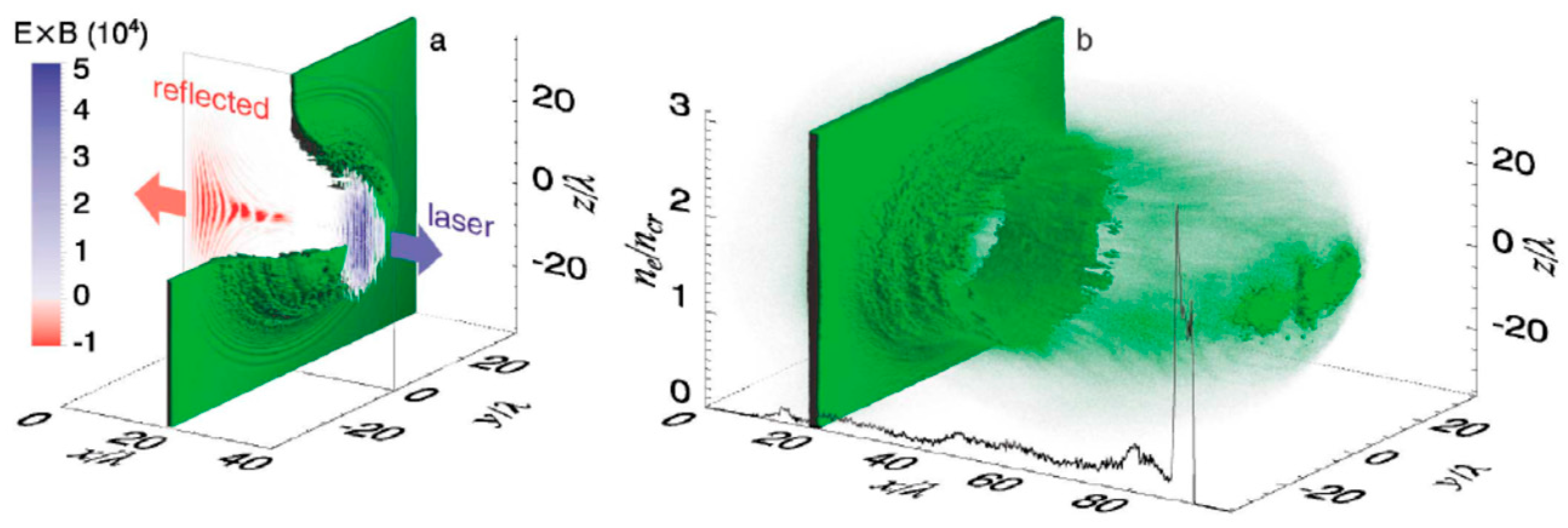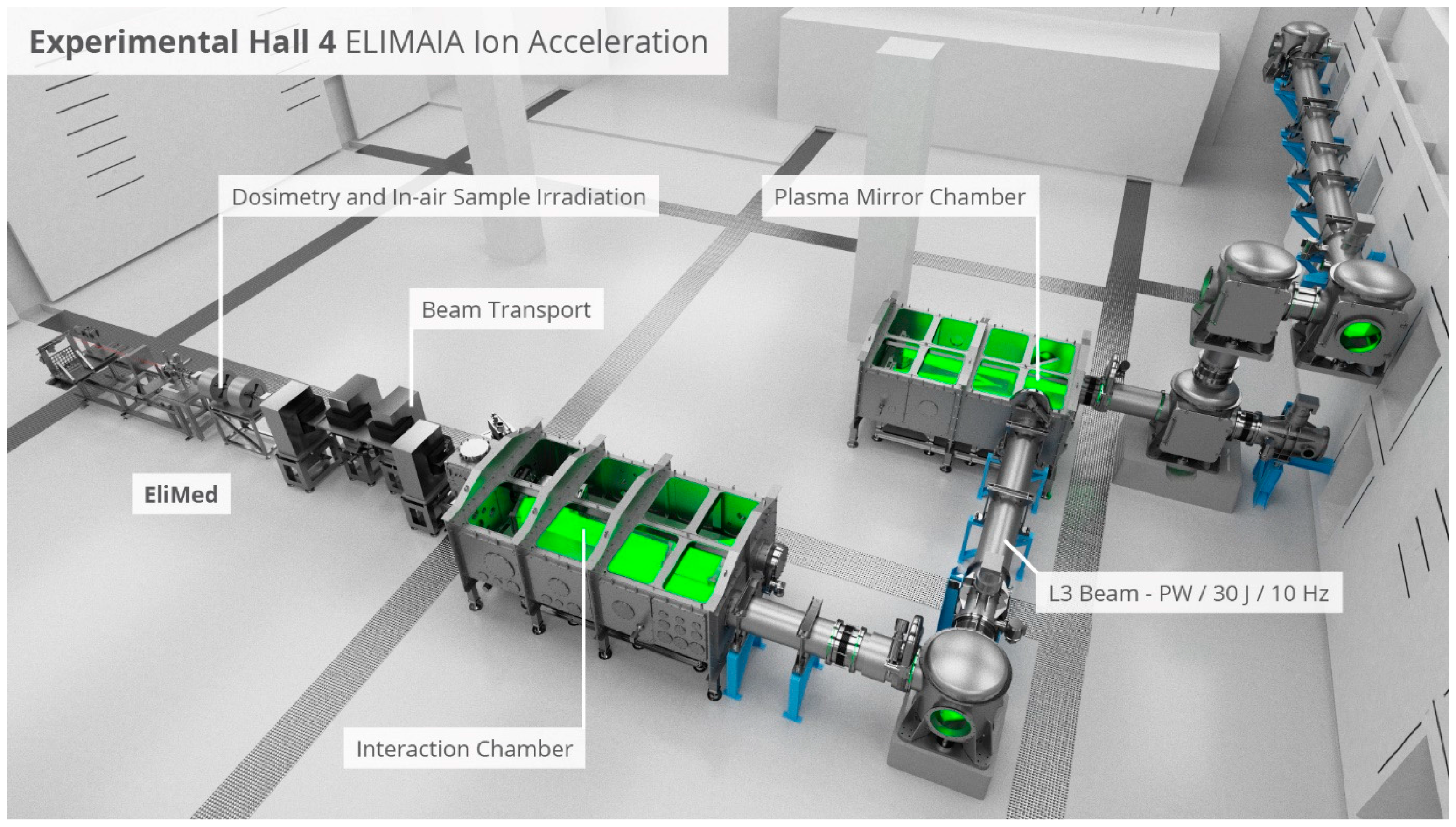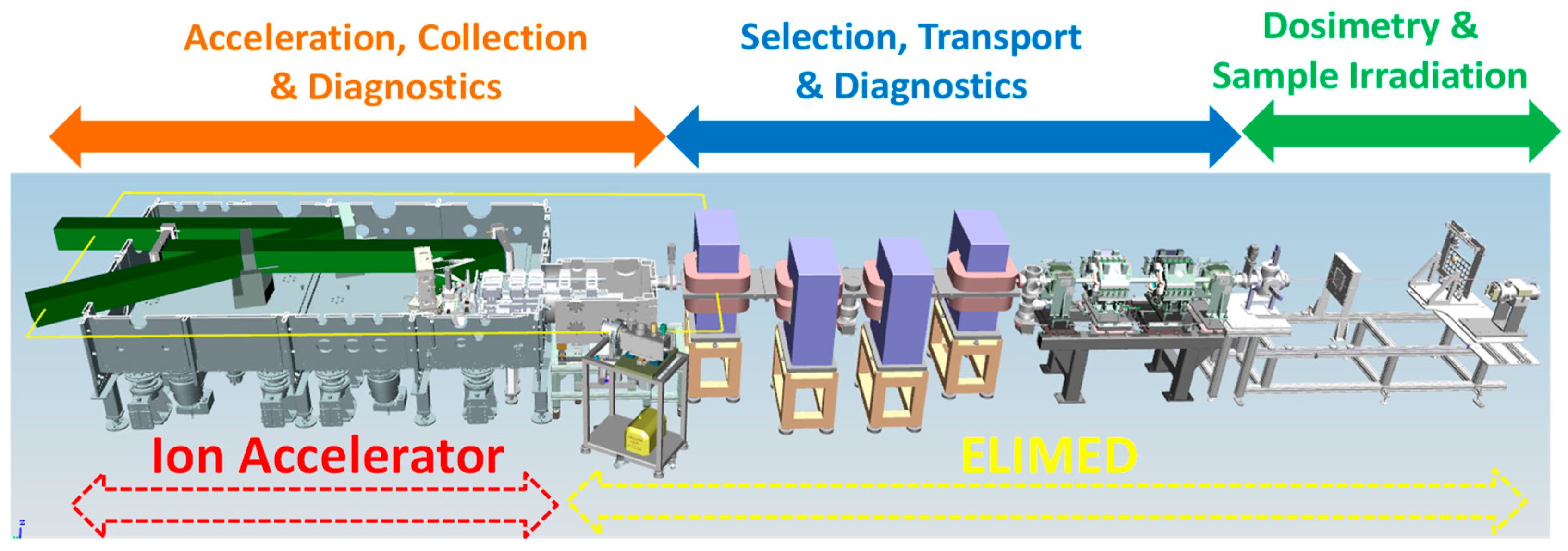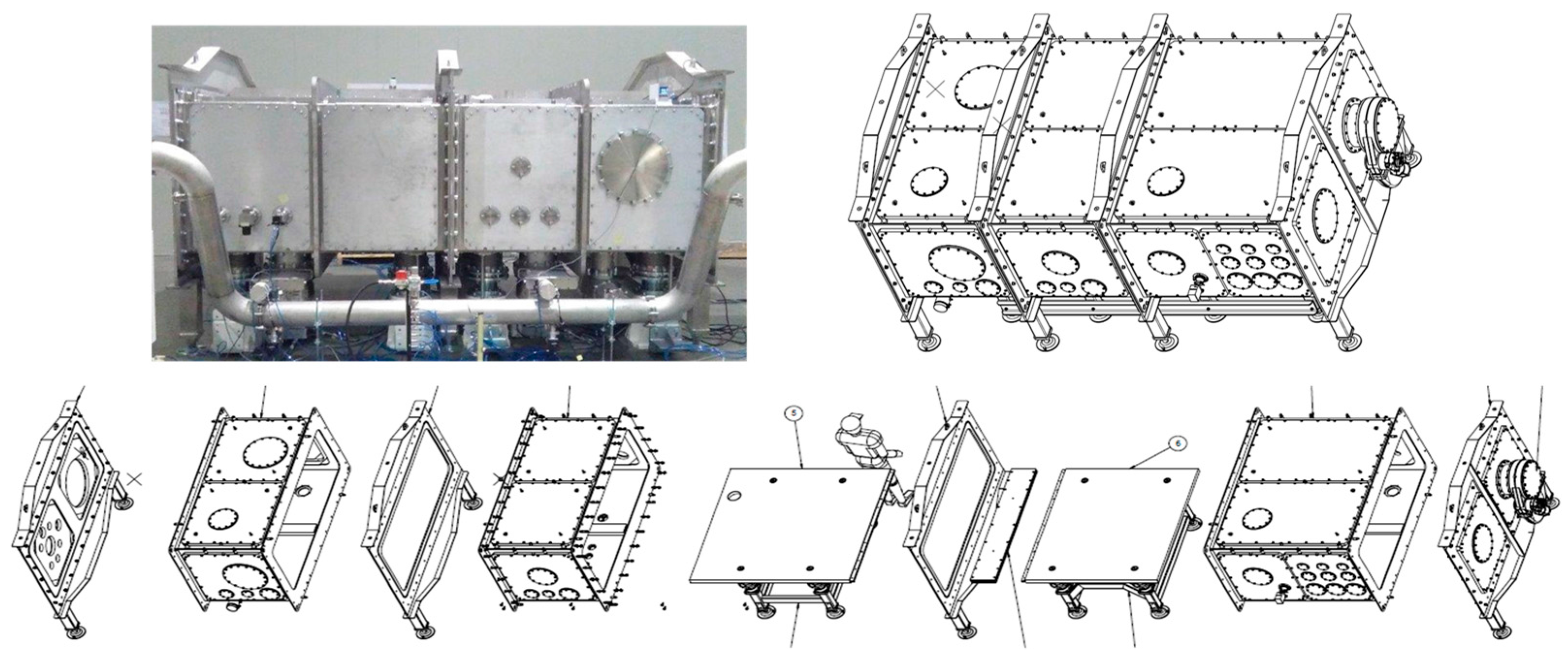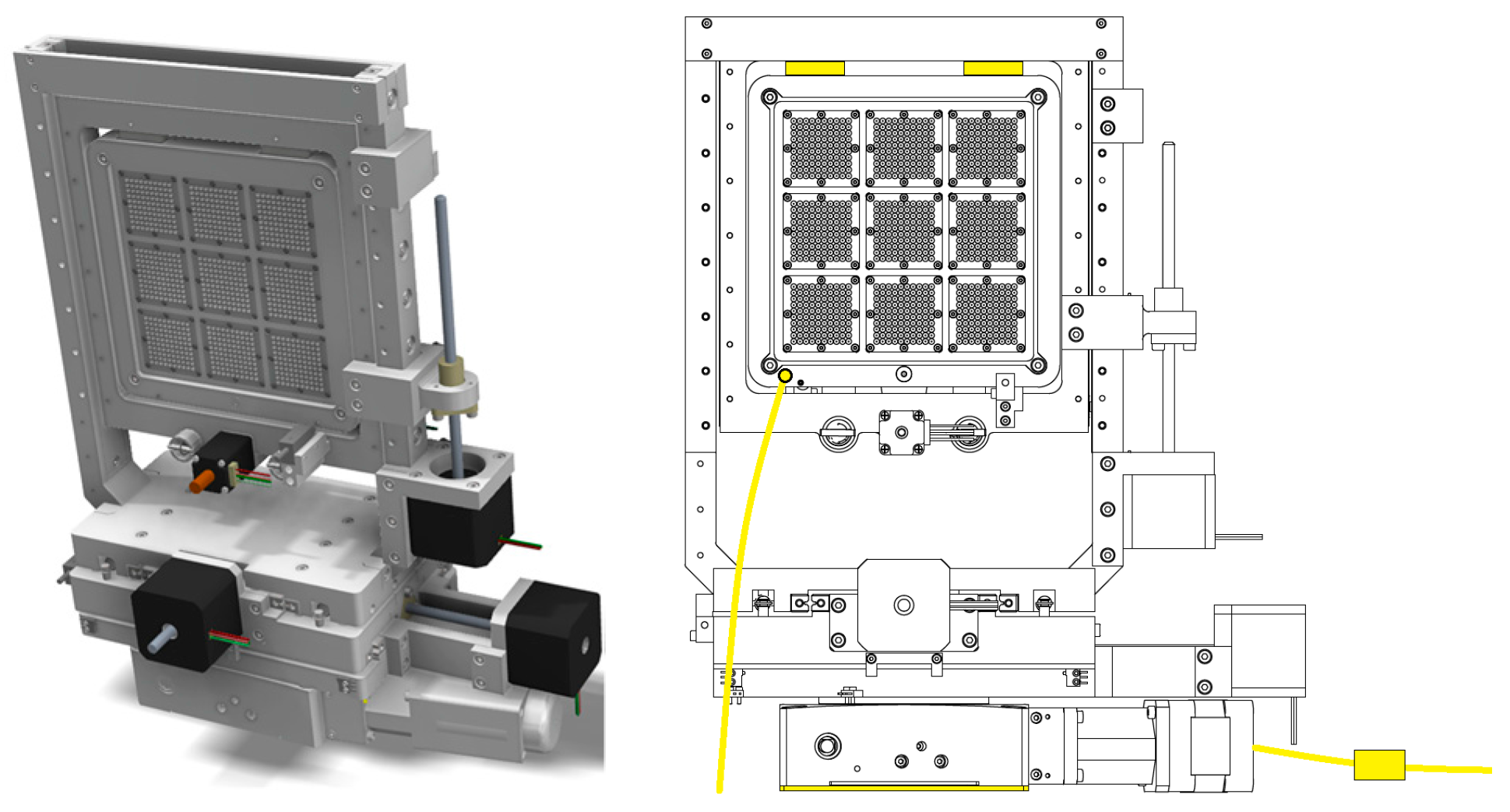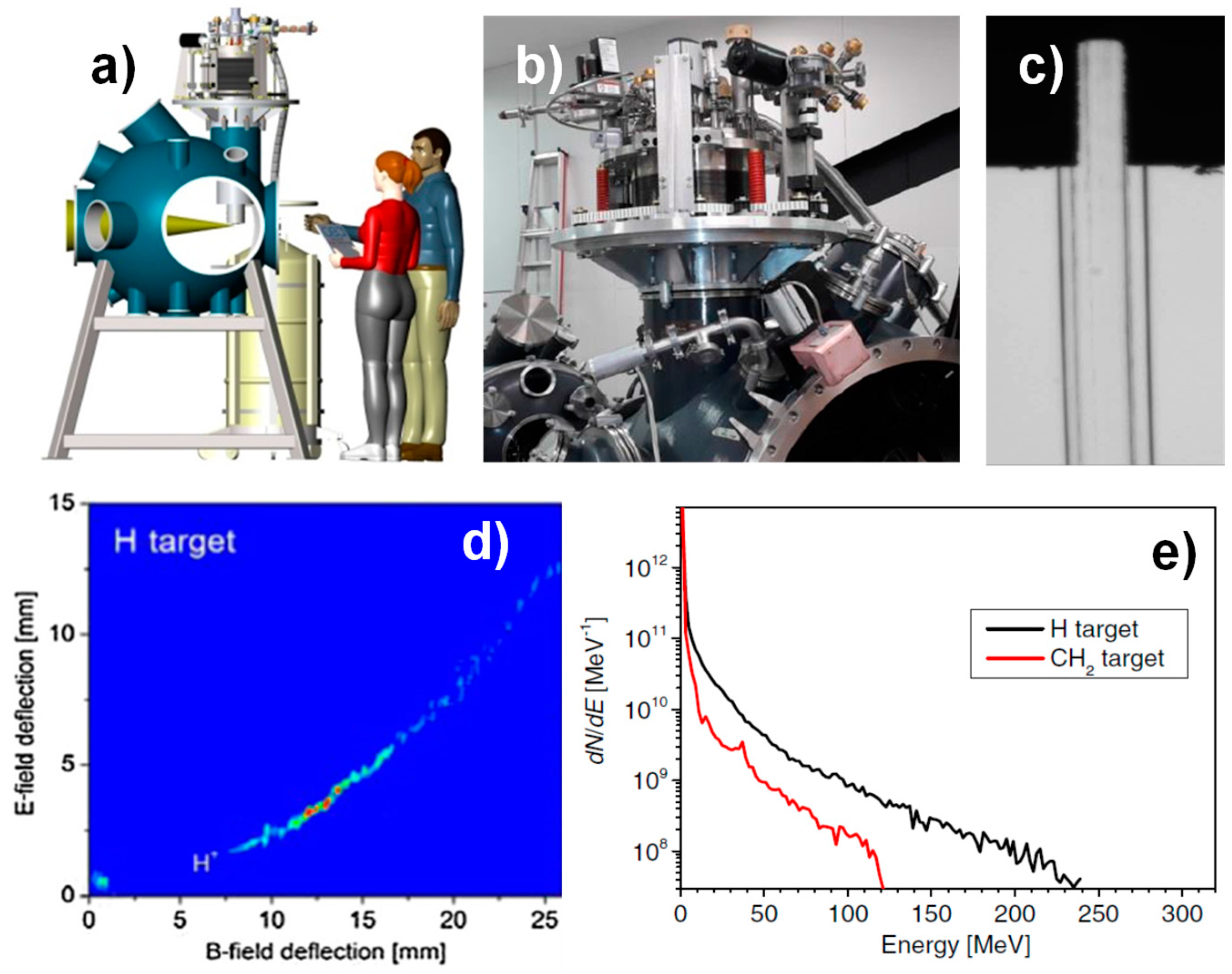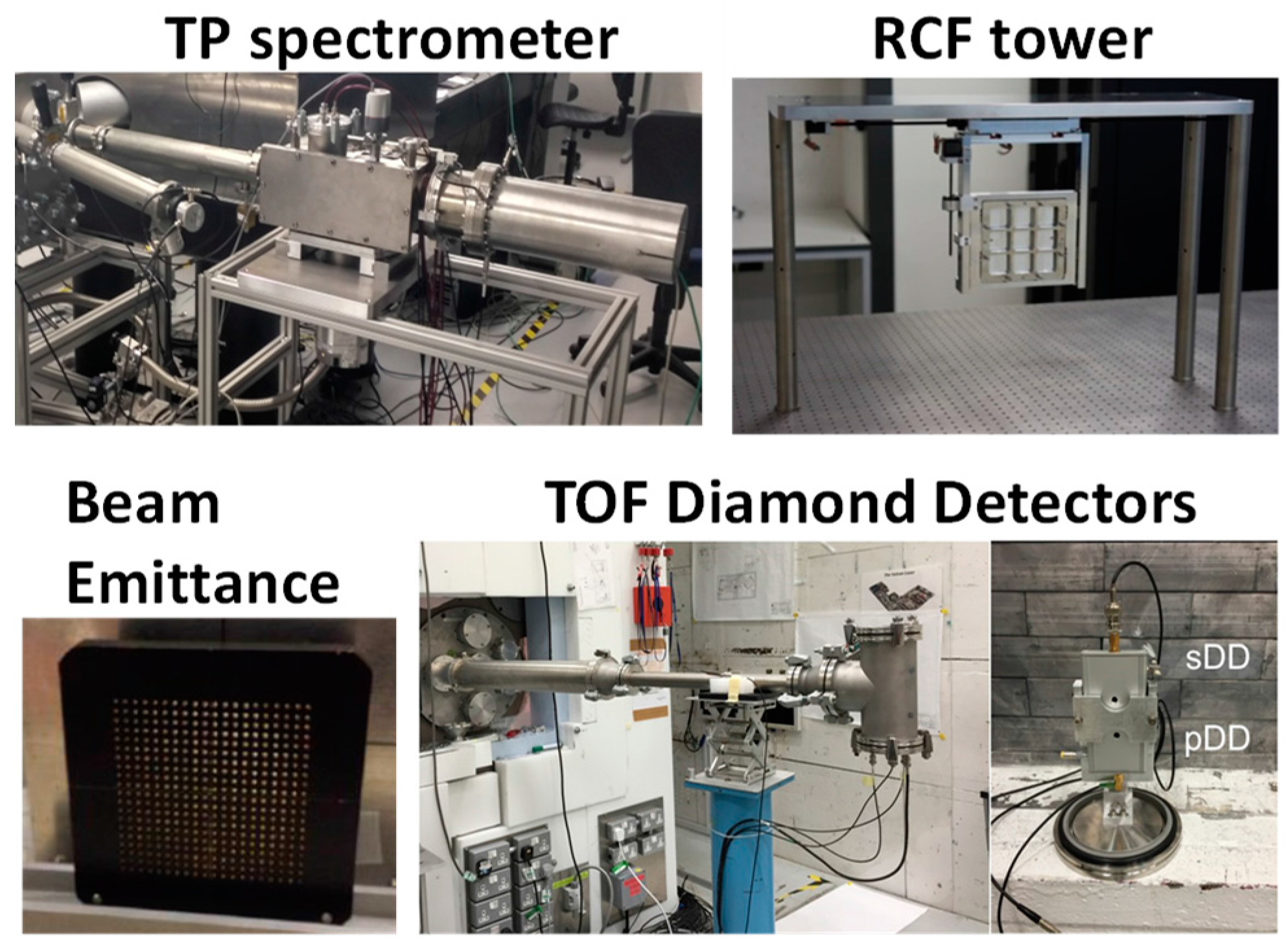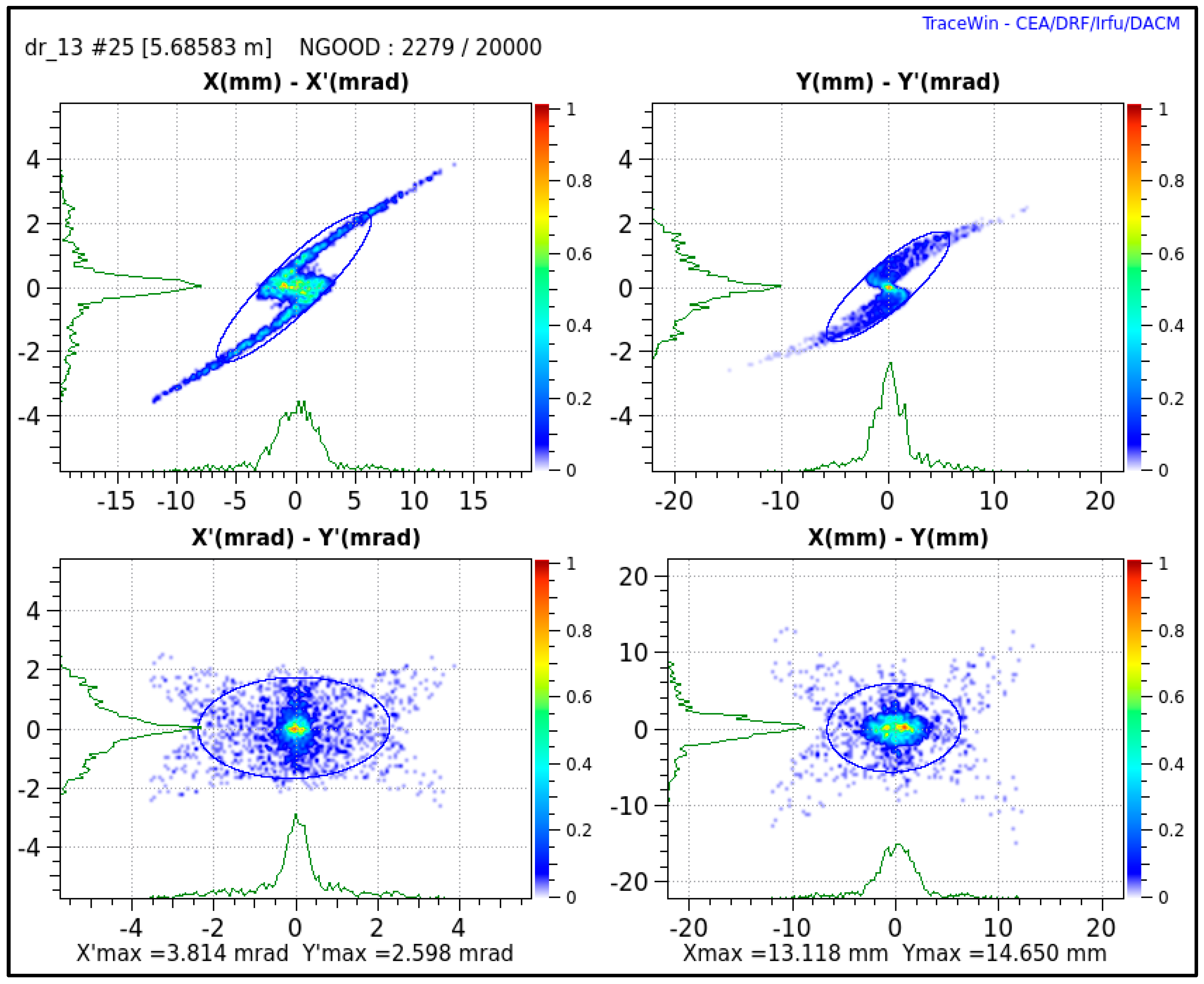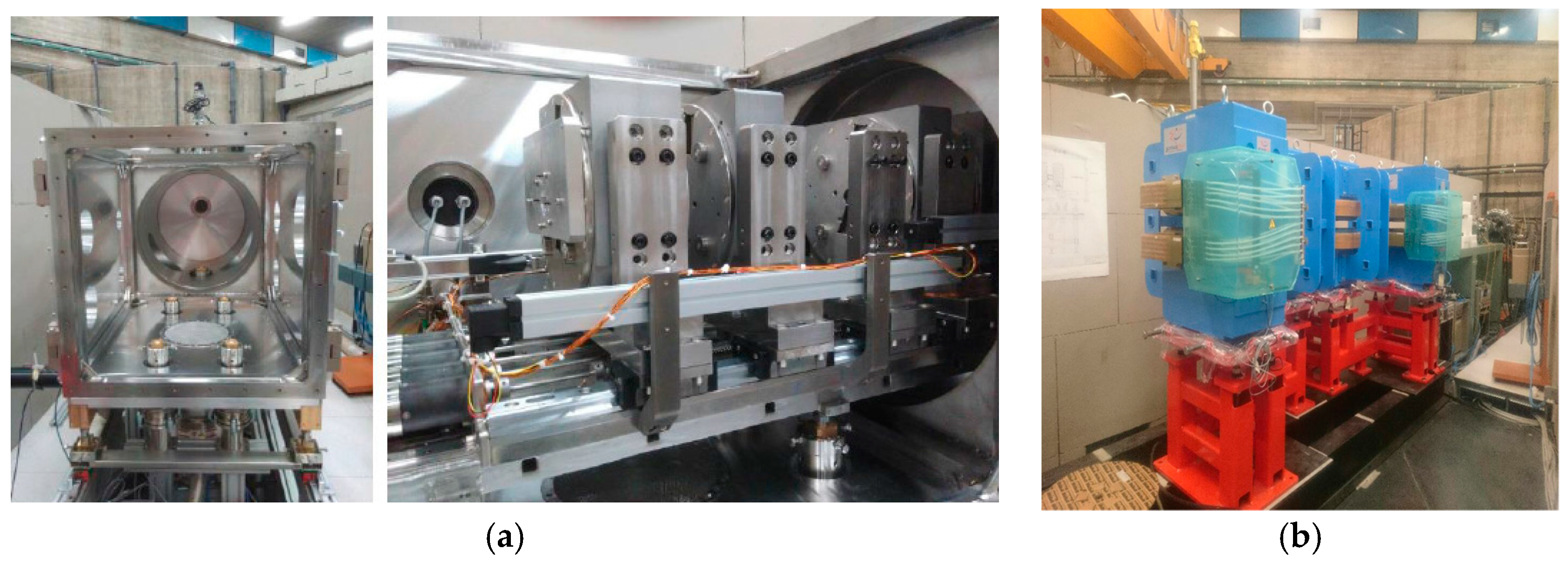1. Introduction
Laser-plasma ion acceleration is a new field of Physics rapidly evolving thanks to the continuing development of high power laser systems, thus allowing to investigate the interaction of ultrahigh laser intensities (>10
19 W/cm
2) with matter. As a result of such interaction, extremely high electric and magnetic fields are generated. Such tremendous fields, which can be supported only in plasmas, allow to accelerate particles at relativistic energies by very compact approaches (in sub-mm distances). Typically, these high energy ion beams are produced in thin (μm-scale) solid targets and accelerated by a sheath field developed at the target-vacuum interface as a consequence of the generation of relativistic plasma electrons (“hot electrons”) propagating into vacuum. Ion acceleration takes place until charge neutrality is restored and ultimately ions and electrons move together in a ballistic way. According to the state-of-the-art in laser-driven ion acceleration, maximum proton energies of several tens of MeV have been experimentally demonstrated with a relatively high yield (10
10–10
12 protons/pulse) [
1]. However, laser-accelerated ion beams are still not fully mature for some applications where additional features, such as low divergence, small energy bandwidth, spatial profile uniformity, shot-to-shot stability, are essential. New laser technologies which will be soon available for the scientific community, e.g., fully diode-pumped lasers at ELI-Beamlines [
2], will allow to investigate new regimes which are very promising in terms of future use of laser driven ion beams for various applications, also given the expected high stability of these laser systems.
Hadrontherapy is currently considered to be one of the most advanced and precise external radiotherapy techniques for tumour treatment [
3]. Hadrons have advantages with respect to more conventional radiation sources (electrons and gamma-rays) in terms of both spatial precision of the released dose and biological effectiveness [
4]. Unfortunately, availability of hadrontherapy is still very limited worldwide despite considerable clinical evidence in its favour [
5]. The main reasons for this are huge costs for construction, installation and maintenance associated with complex accelerators (especially for heavier ions) and, in general, technical complexity of the facility management and the fact that other radiation therapies have a longer history of use. The use of more compact hadrontherapy approaches would obviously have a valuable impact on society.
In comparison to the long developmental journey from the initial conventional accelerators back in the 1930s to the full maturity of the current ion beam facilities, laser-driven ion acceleration is clearly still at its infancy. Such non-conventional acceleration schemes have been intensively investigated in the last 15 years and the field is rapidly growing thanks to the continuing development of high power laser systems. The main goal of the laser-driven ion acceleration community is to deliver reliable and very compact approaches to be possibly used for societal applications, with the aim of reducing the overall cost of standard accelerator facilities [
6]. In order to overcome the existing challenges new laser technologies have to be exploited, in particular enabling simultaneously high peak power (multi-Petawatt) and high repetition rate (up to 10 Hz) which are about to be available at ELI-Beamlines (Dolní Břežany, Czech Republic) [
2]. As an example of possible advantages of a laser-based approach, transporting the laser pulse to the treatment rooms to generate the ion source closer to the patient would drastically reduce costs related to ion beamlines, switchyards and shielding. Furthermore, laser-based hadron radiotherapy would uniquely offer the option of synchronous delivery of multiple beams of photons, electrons and different ion species (e.g., He and C ions), with enhanced capabilities for mixed field irradiations, an approach also of interest to cancer therapy [
7].
2. Ion Acceleration by Lasers at ELI-Beamlines
Until now, most of the experiments on laser driven proton acceleration have been performed in the regime known as Target normal sheath acceleration (TNSA) [
1]. Target normal sheath acceleration is based on a space-charge field generated at the rear surface of a micrometer-thick target. Such quasi-electrostatic field is produced by “hot electrons” (generated by the interaction of a tightly focused high power laser at the target front surface), crossing the target bulk and attempting to escape in vacuum from its rear side.
The availability of ultra-high intensity lasers at ELI-Beamlines (>10
22 W/cm
2) will allow entering a new ion acceleration regime known as Radiation Pressure Acceleration (RPA). In fact, the generation of high-density ultra-short relativistic ion beams is predicted in the scheme called “laser piston regime”, where the laser radiation pressure is dominant and the laser energy is efficiently transformed into ion energy. Radiation Pressure Acceleration has been theoretically predicted [
8] but only partially demonstrated experimentally [
9], thus the Research Programme on Particle Acceleration by Lasers (RP3) at ELI-Beamlines will also aim at investigating experimentally unexplored RPA dominant ion acceleration geometries at the ion beamline, ELI multidisciplinary applications of laser-ion acceleration (ELIMAIA) [
10]. Theoretical predictions show that several hundred MeV, quasi monoenergetic proton beams can be accelerated using a PW-class laser in the RPA regime, thus being very promising for future application in hadrontherapy [
11,
12]. A 3D visualization showing a typical ion density distribution in such a regime is depicted in
Figure 1.
The ELIMAIA beamline will be primarily served by a unique laser system available at ELI-Beamlines, called high-repetition-rate advanced petawatt laser system (L3-HAPLS), designed to deliver PW pulses with energy of at least 30 J and durations <30 fs, at a repetition rate of 10 Hz. It is the first all diode-pumped, high-energy femtosecond PW laser system in the world. The laser was developed at Lawrence Livermore National Laboratory (Livermore, CA, USA), with ELI-Beamlines (Dolní Břežany, Czech Republic) cooperating on the development of short-pulse diagnostics and of short-pulse subsystem controls and timing and delivering the PW vacuum compressor. The system was demonstrated to provide highly stable continuous operation at specified energy and pulse duration. HAPLS will be the world’s highest average power Petawatt laser system. The use of another laser, the L4 10-PW system with about 130-fs long pulses, 1.3-kJ energy and a shot rate of 1/min, is also planned at ELIMAIA, but initially limited to its PW-level auxiliary beam (150 J). The architecture is based on direct compression of a broadband beam amplified by a combination of different Nd:glass slabs. L4 is designed to generate an extremely high and unprecedented peak power, thus will be used at ELIMAIA to explore new acceleration (RPA-dominant) regimes for proof-of-principle experiments since the laser repetition rate will not be ideal for systematic user applications.
Several foreseen applications of laser driven ion beams require a substantial increase of the energy per nucleon well beyond 100 MeV. Up to now, the maximum energy of protons accelerated from solid targets in the TNSA regime is 85 MeV [
13]. Recently maximum proton energy of 94 MeV has been reported in a transparency-enhanced hybrid acceleration scheme [
14], along with some experimental findings that may limit sheath acceleration of high energy protons due to self-generated surface magnetic fields [
15]. In comparing all these values, one should however exert some caution, as the highest energies reported may not necessarily correspond to an effective cut-off energy, but may be determined instead by the energy at which the spectral signal decreases below the instrumental detection threshold, thus making the ion source at the given maximum energy not usable for applications due to a very low flux. Currently laser intensity available on target is a limiting factor on the maximum achievable ion energy. While intensities of the order of 10
22 W/cm
2 have been reported [
16], in practice it is very difficult to reproduce them on a daily basis. The next generation of laser facilities, such as ELI-Beamlines, will allow higher intensities than this value, hence paving the way towards higher ion energies. Nevertheless, there are other beam parameters, which are of relevance and need to be improved or controlled for specific applications. For instance, TNSA proton beams are highly laminar and have very low emittance [
17], but their divergence is a concern for applications requiring ion transport to a secondary target (user sample); TNSA energy spectra are ordinarily broad and thus unsuitable for direct use in many applicative contexts. Furthermore, for most applications, including cancer therapy, the requirement of reaching sufficiently high energies is coupled to the need of having a sufficiently large number of particles in the energy range under consideration. These issues motivate scientists to search for new ion acceleration mechanisms exploiting the potential both of advanced target engineering and of nonlinear-relativistic optical effects in plasmas [
1]. However, the understanding and experimental implementation of fundamental processes governing these mechanisms are still under development. As mentioned above, RPA is considered the most promising mechanism and is currently attracting a substantial experimental and theoretical attention due to the predicted superior scaling in terms of ion energy and laser-ion conversion efficiency. In this context, the scheme known as Light Sail (LS) acceleration [
8,
9], where for a sufficiently thin foil the whole laser-irradiated area is detached and pushed forward by the laser radiation pressure, is particularly promising.
Alternative mechanisms for acceleration of protons but also light ions (heavier than protons) exist and will be investigated at ELIMAIA. Whereas carbon ions require 400 MeV per nucleon to reach the same penetration depth in water as 250 MeV protons, helium ions require only 250 MeV per nucleon, which is the lowest energy per nucleon among the light ions. This fact, along with the larger biological damage to cancer cells achieved by helium ions in comparison to protons and the absence of radiobiological side effects caused by nuclear fragmentation issues (typical of carbon or lithium ion therapy) makes this species an interesting candidate for future medical applications of laser-driven ion sources. Two different mechanisms (magnetic vortex acceleration and hole-boring radiation pressure acceleration) of PW-class laser ion acceleration from liquid and gaseous helium targets are reported in our recent theoretical paper [
18] with the goal of producing 250 MeV per nucleon helium ion beams that meet the hadron therapy requirements.
Figure 2 shows the numerical prediction of magnetic vortex acceleration in case of a near-critical density
3He or
4He target. The laser pulse is efficiently depleted propagating through the whole target thickness (a) and the corresponding maximum ion energies are about 250 MeV per nucleon.
Although various regimes and approaches to laser-plasma acceleration are currently very actively being studied, both theoretically and experimentally, such non-conventional ion sources are not suitable for several multidisciplinary applications yet, especially in comparison to ion sources available at conventional accelerator facilities. For this reason, as an intermediate solution to make such beams attractive for users, a few experimental groups have developed hybrid methods (laser particle acceleration combined with conventional particle beam transport solutions) aimed at improving the main features of laser accelerated ion beams (divergence, spectral bandwidth, flux at the irradiated sample, shot-to-shot stability) [
19,
20]. This approach is also being implemented at ELIMAIA, at least in the first phase of operation since it is robust, reliable and will allow to use stable laser-driven ion beams on user samples of interdisciplinary interest. Nevertheless, innovative and compact (all-optical) techniques are being proposed and will also be implemented at ELIMAIA, such as the “coil target” approach recently reported in [
21], or the concept of capillary-discharge active lenses [
22]. The coil target scheme allows to optimize the properties of TNSA protons exploiting the large amplitude electric field associated to the electro-magnetic pulse (EMP), which is generated during high-intensity laser-matter interaction [
23,
24]. This method shows that if a helical coil is attached to the rear of a laser-irradiated foil, the propagation of the EMP along the helix can affect significantly the properties of the TNSA proton beam accelerated from the foil. By suitably choosing the coil parameters (pitch and radius), one can synchronize the advance of the EMP along the coil’s axis with protons of a given energy within the broad TNSA spectrum, constraining their divergence while at the same time boosting their energy. This technique has been demonstrated to generate high flux proton beams at near accelerator quality (narrow band energy spectra, high degree of collimation) at energies up to several tens of MeV.
3. ELIMAIA-ELIMED: A Laser-Accelerator for User Experiments
The ELIMAIA beamline will be one of the key secondary sources of the ELI-Beamlines facility. ELIMAIA has been designed and developed at the Institute of Physics of the Academy of Science of the Czech Republic (IoP-ASCR) in Prague and at the National Laboratories of Southern Italy of the National Institute for Nuclear Physics (LNS-INFN) in Catania (Italy). The proposed technological and scientific solutions for the ELIMAIA implementation are the result of a complex investigation carried out with the main goal of fulfilling the specific requirements that have been coming from the international user community [
23]. The main identified user requirements are: wide energy and flux range, small energy spread (quasi-monoenergetic beams), homogeneous transverse beam distribution, shot-to-shot stability (energy and flux), variable beam spot size, full beam control (flux and dose) with <5% error, possibility of in-air user sample irradiation (e.g., for bio-samples), use of different ion species (H, He, Li, C). The general philosophy for the design, development and implementation of the ion beamline at ELI-Beamlines is based on three key features: user friendly approach, accurate monitoring and reliability of the accelerated ion beams and flexibility for its future upgrade.
A complete experimental platform (laser beam transport and pulse treatment, ion source generation and in situ characterization, ion beam transport, diagnostics and shaping, online dosimetry and in-air sample irradiation end-station) will be available for users to enable them to apply laser-driven ion beams in multidisciplinary fields. A 3D rendering of the ELIMAIA beamline (Ion Accelerator + ELIMED) is shown in
Figure 3. The ELIMAIA beamline is located in the southern part of the experimental hall 4 (E4), in the basement of the ELI building (required from a radiation protection point of view). The available L3 and L4 (1–10 PW peak power level) lasers enter E4 from the eastern wall (only L3 is shown in
Figure 3). The ELIMAIA beamline consists of two main subsystems: (i) the Ion Accelerator and (ii) the ELI MEDical applications (ELIMED) beam transport and dosimetry section. ELIMAIA key technologies will be described in the following (different subsystems and key equipment are also shown in
Figure 4).
One of the goals of ELIMAIA expert user community will be to demonstrate that the overall cost of standard acceleration facilities can be drastically reduced by using innovative compact approaches based on high power laser-matter interaction. In fact, the main goal of the ELIMAIA beamline is to provide stable, fully characterized and tuneable particle beams accelerated by PW-class lasers and to offer them to a broad community of users interested in multidisciplinary applications, as well as in fundamental science. An international scientific network, also called ELIMED, particularly interested in future applications of laser-driven ions in hadrontherapy, has already been established [
25]. However, this is only one of the potential applications of the ELIMAIA beamline, which will be open to several proposals from a multidisciplinary user community. These proposals will be for areas such as non-conventional ion acceleration at high repetition rate [
1], radiation biology with short ion bunches (ultrahigh dose rate) [
26,
27,
28], radiation chemistry (e.g., pulsed radiolysis of water) [
29,
30], time-resolved proton radiography of dense objects [
31], pitcher-catcher nuclear reactions generating isotopes for positron emission tomography (PET) [
32,
33] or producing high brilliance secondary radiation sources (e.g., neutrons and alpha-particles) [
34,
35], study of ion stopping power in plasmas [
36], proton induced x-ray emission (PIXE) or proton activation analysis (PAA) techniques for cultural heritage [
37], space-grade electronics [
38], pump-probe investigations of warm dense matter [
39], fast ignition approach to inertial confinement fusion [
40]. These anticipated user experiments can be grouped in two main categories: (i) source development and (ii) application experiments and will be realized in two different user setups, “open station” and “service station”, respectively, as schematically shown in
Figure 5.
Table 1 summarizes the ELIMAIA-ELIMED user offer in two different phases of its implementation, which will depend on the maturity of the laser beams (primary sources) and on the development of the ion beams (secondary sources) at ELI-Beamlines.
3.1. The Ion Accelerator
The first sub-system of the ELIMAIA beamline is the “Ion Accelerator”, which consists of a double plasma mirror (DPM) chamber, a local laser diagnostics (LSD) station and an interaction chamber. The DPM system allows to increase the nanosecond-scale laser contrast (ratio between the intensities of the main femtosecond pulse and the typical nanosecond pedestal), which is required if ultrathin (<100 nm) foils are used as target. The beam then continues its propagation through the laser diagnostic section where a set of basic laser parameters (spatial profile and energy) are monitored in air shot-by-shot. Laser pulse duration, wavefront and focal spot are monitored in vacuum in the interaction chamber, where a set of mirrors (including a deformable mirror) and an off-axis-parabola (OAP) are also placed to transport and focus the laser beam down to a few micrometers on target. A target delivery system (translational target tower) along with its alignment/monitoring system is used for accommodating foil targets of various thickness and geometry depending on user requirements. The main proton/ion beam produced at the laser-target interaction point propagates from left to right (see
Figure 4 and
Figure 5) towards the ELIMED section.
Table 2 provides a summary of the main equipment of the ELIMAIA Ion Accelerator section which will be available for expert users (“open station” setup). A photo of the recently manufactured and tested experimental chamber unit (ECU) vacuum chamber is shown in
Figure 6. The ECU concept, developed at ELI-Beamlines, allows extensive flexibility for future increase of the chamber volume (modular solution), high stability of the optical setup (de-coupled breadboards) and, at the same time, easy access and use of the entire space inside the chamber (the Al panels are fully dismountable), as shown in
Figure 6.
3.2. Target Delivery Systems
Considering the potential use of L3 at ELIMAIA with a repetition rate of 10 Hz, a number of technological issues related to target delivery will be raised: fast target refreshing, positioning and alignment, target debris damages of laser optics, target fratricide. In fact, these issues could represent a bottleneck in exploiting the full potential of high peak power, high repetition rate lasers, especially when the generation of secondary particles and radiation sources for applications is one of the goals, such as for the ELIMAIA beamline. One of the most common target delivery solutions in the field of laser-driven ion acceleration is the use of planar foils which allows positioning multiple targets by translating or rotating a holder containing arrays of samples. This geometry is optimal when the targets are produced as a continuous sheet of material, such as a thin foil or a wafer. This type of delivery system often allows to mount the target holder in a standard frame usually connected to stepper motors. A similar concept has been developed for ELIMAIA (see a rendering in
Figure 7). The ELIMAIA target tower is relatively compact (its main frame is 20 × 20 cm), offers five degrees of freedom with micrometer resolution and in its first version it allows loading 900 targets (considering an average distance of about 5 mm between neighboring targets), but has been designed to readily scale up to several times that number of targets without inherently reduced accuracy. From a purely target positioning performance standpoint (i.e., independent of performance of targets themselves) it is currently able to perform at 10 Hz (burst of laser shots). However, how well positioning accuracy and neighbouring targets are maintained at higher rates does remain to be verified. The structure has been designed to remain stable and free of oscillation at higher speeds, also with the support of finite element analysis. Electro-magnetic pulses (EMP) associated to high intensity laser-matter interaction can seriously affect the operation of electronics and high precision motorized systems, thus the ELIMAIA target tower has been designed accurately to eliminate, or at least reduce, this issue. A schematic view (yellow parts) of the ELIMAIA target tower measures taken against potential EMP damages is shown in
Figure 7: the PTFE (polytetrafluoroethylene) baseplate discourages electrical current from travelling through portion of tower attached to actuators; the targets are isolated via polyether ether ketone (PEEK) flexures; the part immediately preceding portion of tower hit by laser is fabricated from insulating material; the target plate is directly grounded to the vacuum chamber; the electrical conductor runs directly from the target plate to the ground; relays are present on every cable; cables are encased in copper braid; all cables are shielded and additionally surrounded by copper braided sleeving material.
In an advanced phase, for an extended use of 1–10 Hz laser repetition rate, different target delivery systems will have to be implemented at ELIMAIA. Currently a cryogenic ribbon target delivery systems, experiments on laser interaction with solid hydrogen (ELISE) is being co-developed with the group of the Low Temperature Laboratory of CEA (Grenoble, France) [
41]. Such a system enables the production of a continuous flow of a solid-H
2 slab (ribbon) through a newly designed extrusion apparatus that does not contain any movable parts. The thermodynamic properties of a H
2 fluid are used to generate a pressure rise in a cell and push the solid H
2 out through a calibrated nozzle. The solid-H
2 ribbon has a 1-mm width, controllable thicknesses (50–100 μm) depending on the nozzle employed and an electron density of 5.36 × 10
22 cm
−3 (step-like). The experimental cell for the solid-H
2 ribbon production is equipped with two heat exchangers, one situated at its base and another one situated at its top, enabling the cell to achieve the required temperature values. More details about the ELISE working principle and functional tests are reported in Ref. [
41,
42]. The main parts of the ELISE installation are: (i) a cryostat cooled with liquid helium through a transfer line connected to a Dewar, (ii) an electrical cabinet situated close to the experimental chamber, (iii) an ad-hoc electrical shielding system to prevent disturbances from EMP during high-energy laser-matter interaction and (iv) a differential pumping system. The generation of pure hydrogen plasma has advantages from the experimental point of view in terms of plasma itself and its characterization (single ion species), as well as for future multidisciplinary applications of laser-accelerated proton beams, since such a target delivery system can potentially be used at high repetition rates and is essentially debris free. Furthermore, benefits for theoretical modelling and numerical simulations are evident. In fact, H plasma can be considered as an ideal sample for theoretical investigations and their experimental verification both in terms of accuracy (a lower number of approximations is needed) and also reduced computational time for modelling. The ELISE solid hydrogen target delivery system has already been tested in plasma environment using kJ-class lasers at TW and PW peak power, respectively at PALS and RAL [
42].
Figure 8 shows a 3D model of the experimental installation during the PALS experiment (a), a photo of ELISE (b), a front-side picture of the hydrogen ribbon (c), a raw data picture from the ion energy spectrometer (d) and the result of numerical simulations (e) highlighting that using the L3 laser and a suitable solid-H
2 target thickness (5 μm) proton acceleration is favourable in terms of maximum energy and total beam charge in comparison to a plastic foil [
42].
3.3. Ion Diagnostics
One of the main challenges in the detection of laser-accelerated ions is the high-pulse flux (10
10–10
12 ions/pulse) and the short bunch duration (0.1–1 ns near the source), hence the very high dose-rates in a single pulse (10
9 Gy/min) compared to those of conventionally accelerated beams [
43,
44,
45]. Moreover, the desired particles are embedded in a mixed radiation background due to by-products of the acceleration process itself, such as electrons and photons. Thus, innovative techniques and devices for beam diagnostics have to be developed since a robust online diagnostics represents one of the crucial steps towards multidisciplinary applications of such non-conventional beams. Accurate ion diagnostic and dosimetry tools are required along the ion beam transport line to ensure that only the desired ions in the requested energy range are delivered to the user sample, fulfilling the requirements of high accuracy and high flux environment. A few technical solutions are implemented into the ELIMAIA beamline.
In order to monitor the main beam characteristics (ion energy spectrum, angular distribution, flux and species) along the beamline, a set of real-time detectors has been developed. The main diagnostics is based on the time-of-flight (TOF) technique and on the use of diamond (poly and single crystal) and silicon carbide detectors. These devices show interesting characteristics, such as high time and energy resolution, radiation hardness and low capacitance, which makes them particularly attractive for TOF measurements of high intensity particle bunches at high repetition rate. TOF technique is one of the most established real-time diagnostics methods as reported in literature [
46,
47,
48,
49,
50,
51,
52], hence offering the possibility to monitor shot-by-shot the main ion beam features up to a repetition rate of 10 Hz.
At least three TOF detectors will be placed along the ELIMAIA beamline: one close to the interaction area (about 1 m from the target) as a part of the Ion Accelerator section and two as part of the ELIMED section (one placed about 2 m downstream, after the permanent quadrupoles and the other one placed about 9 m downstream, after the energy selection system). The first TOF detector will be coupled with a Thomson Parabola ion spectrometer (see below) and used for measuring the total ion current during optimization of the source. This device will additionally allow to estimate proton cutoff energies up to 50 MeV with an acceptable resolution. The second TOF detector, placed in the first section of the ELIMED beam transport line will allow to monitor shot-by-shot the ion beam leaving the permanent quadrupoles in terms of stability of current and energy spectrum, in particular measuring the energy cutoff of the focused ion beam just before the entrance of the energy selection system. The third TOF detector placed in the final section of the transport line will allow to measure the energy distribution of the transported ion species along with their ion flux, hence the energy bandwidth which is one of the most important requirements from the users. Such an ion beam diagnostic setup is a key feature of the ELIMAIA beamline since it allows to optimize ion beam transport and selection and to tune in real-time the particle beam transport optics. The ELIMAIA TOF diagnostics have already been tested with laser-driven proton beams generated by the VULCAN-PW laser facility at the RAL Central Laser Facility (Didcot, UK) up to energies exceeding 30 MeV [
52].
Thomson Parabola Spectrometer (TPS) is a diagnostics able to detect energy-resolved ion spectra while discriminating ions with different charge-to-mass ratios by means of a combined use of electric and magnetic fields [
53]. The ion beam, selected by a pinhole located at its entrance, travels through regions of parallel magnetic and electric fields applied transversely to the beam axis. Deflected ions are observed and amplified by means of a micro channel plate (MCP) and are sent to a phosphor screen, thus producing an image of the energy-resolved ion spectra subsequently detected by a CCD camera. Acquisition of the raw image by the CCD is controlled by a trigger signal from the laser. The main parameters of the ELIMAIA TPS, fully designed, realized and calibrated at ELI-Beamlines, are reported in the following. The diameter of the smallest of the two pinholes is usually set to be 200 μm. The permanent magnets have 5 cm in length and allow reaching a magnetic field strength of about 1.2 T. The maximum voltage that can be applied on the 20 cm long electrodes is ±15 kV. The micro channel plate with 77 mm of active diameter consists of a lead glass plate including an array of electron multipliers with diameter of the tube equals to 21 μm. The channel axes are biased by a small angle (6°) to optimize secondary electron emission in the channels. A double MCP with an aspect ratio of 40:1 amplifies the signal typically by a factor of more than 5 × 10
6. The ELIMAIA TPS has its own differential pumping station (able to reach a vacuum level of 4 × 10
−6 mbar) and a set of power supplies for feeding the electric field electrodes, the MCP electrodes and the phosphor screen by ±15 kV, −2 kV and +5 kV, respectively. The alignment system allows adjusting the TPS in the horizontal plane in two transverse directions and two rotational units help in pointing the system at the target.
A Beam Emittance Detector (BED) has been designed and realized to be installed at ELIMAIA to characterize the ion beam focused by the ELIMED permanent magnet quadrupoles (PMQs). Such detector will be positioned downstream the PMQs system and can be inserted into the beam axis (reference trajectory) by a motorized system. The ELIMED BED is based on the pepper-pot operating principle and consists of three main parts: a grid, a plastic scintillator and an optical system (mirror + CCD camera). Acquired images will be elaborated in real-time using a dedicate software.
A full characterization of ion beams generated by the interaction of the L3 PW laser with thin targets in the ELIMAIA vacuum chamber, based on passive detectors will be also important to provide unambiguous measurements of maximum ion energy, charge and beam divergence and to cross-calibrate the measurements performed by active detectors (e.g., by TOF, MCP). A typical solution for laser-plasma environment consists in using radio chromic films (RCF), nuclear track detectors (typically CR39) and image plates (IP). It is possible to use such detectors in stack geometry to provide a measurement of the ion energy spectrum. Such detectors can be placed in vacuum and are normally positioned very close to the laser-target interaction point (usually only a few cm from the target) due to the typical large ion beam divergence. However, since this is a destructive diagnostics (no ion beam will be transmitted downstream) it has to be positioned in a sort of motorized tower (holder) to be moved in/out the ion beam, depending on the experimental needs. A passive detector tower will also be available at the ELIMAIA interaction chamber for holding various types of passive detectors, which will be used for “calibration shots” in terms of ion beam key parameters. Such a tower was designed to accommodate several passive detector stacks. The main part of the device is the holder, which consists of a metallic frame and two plates for fixing the passive detector in a sort of “sandwich” geometry. The main frame is fixed with a rail on the bottom part of the bridge basement. Two plates are fixed on this frame: the front plate has nine holes for irradiation during nine different laser shots. The back plate is fixed on the main frame by screws and can be easily removed to change the irradiated passive detector with new ones (in principle such operation might be handled by a robotic arm).
Pictures of some of the ion diagnostics developed for ELIMAIA are shown in
Figure 9.
3.4. Ion Beam Transport
The ELIMED ion beam transport section is divided into three sub-systems: ion collections, energy selection, beam shaping. The collection system allows to focus the particle beam accelerated at the laser-target interaction point and to provide a rough energy selection. It consists of a set of five PMQs with high magnetic field gradient [
54,
55] (~100 T/m on a 36 mm magnetic gap). The collection system is provided with mechanics which allows tuning the magnetic optics for different energies, thus improving the matching with the energy selection system. Ions with a given energy range are focused in order to position the beam waist in correspondence of the energy selection point in the radial plane and to present a reduced angular aperture on the transverse plane. This is crucial to maximize the efficiency of the energy selection system (ESS). The latter consists of a double dispersive mode magnetic chicane, in turn made of four electromagnetic dipoles and a selection slit set in the middle plane [
56]. The ELIMED ESS allows to select energy ranges required by the users. It is designed to select protons with energies up to 300 MeV and heavier ions with energies up to 60 MeV per nucleon. Energy selection system works on a fixed reference orbit, i.e., the magnetic field has to be varied from 0.63 T up to 1.22 T to cover the entire expected ion energy range and the energy spread depends linearly on the slit aperture size (10 mm aperture corresponds to a spread of 10% FWHM).
Figure 10 shows the multi-particle envelope of a 60 MeV monoenergetic beam crossing the PMQs and the ESS regions. The proton beam shape at the exit of the ESS is shown in
Figure 11.
Downstream the energy selection section, the ion beam is transported into the final beam shaping section, consisting of two resistive quadrupoles (gradients up to 10 T/m) and two steerers for a fine focusing and alignment of the ion beam onto the user sample.
Figure 12 shows the PMQs and its dedicated chamber (a) and the four dipoles of the ESS (b) installed at LNS-INFN during their calibration with conventional ion beams accelerated by a superconductive cyclotron.
3.5. Dosimetry and Sample Irradiation
Several tasks need to be fulfilled prior to multidisciplinary applications of laser-accelerated beams, especially the medical ones. In fact, beyond standard requirements such as shot-to-shot operational stability, a reliable and precise dosimetric characterization of laser-accelerated particle beams is needed [
57,
58,
59]. The pulsed feature of such particle bunches makes them significantly different from standard accelerator beams in terms of bunch duration, peak current and corresponding pulse dose-rate. Laser-accelerated ion beams are typically characterised by: (i) very high intensities per pulse with a very short duration, (ii) extremely high dose rates, (iii) broad energy spectra, compared to conventional clinical proton beams. These specific ion features do not allow to use conventional dosimeters typically employed and suggested in international protocols for dosimetry, mainly due to ion recombination effects [
60].
The ELIMED dosimeters have been designed and realized to be dose rate independent, to work in laser-plasma environment (typically accompanied by a large EMP) and to allow real-time dosimetry measurements with an accuracy of less than 5%. In particular, a secondary electron monitor (SEM) and a multi-gap ionization chamber (IC) are used for relative dosimetry. Furthermore, a Faraday cup (FC) specifically designed to decrease uncertainties in the collected charge has been realized to perform absolute dosimetry at the sample irradiation point [
56]. Finally, a sample irradiation system (SIS) is installed at the end of the ELIMED in-air section to allow positioning of various user samples, especially biological cells, with a sub-mm precision. A sketch of the ELIMED dosimetry and sample irradiation section is shown in
Figure 13. The SEM detector, placed in a dedicated small vacuum chamber, consists of a thin metallic foil whose working principle is based on secondary electron emission. The multi-gap IC is an innovative prototype designed to carry out non-destructive shot-by-shot measurements of dose delivered onto the user sample. The presence of a second gap close to the first one allows to correct for ion recombination effects caused by the typically ultrahigh dose rate of laser driven ion beams. The IC is intended to be cross-calibrated against the FC absolute dosimeter. The FC has been carefully designed and includes an additional electrode with a special geometrical shape to further repel secondary electrons, thus to increase accuracy of the measured charge.
3.6. Monte Carlo User Application
A Monte Carlo user application of the ELIMED section has been developed using the Geant4 (Geometry and Tracking) code [
61,
62] with the aim of tracking the accelerated proton bunch downstream the different transport elements, diagnostics, dosimeters and up to the user sample, as shown in
Figure 14 [
63,
64,
65]. In fact, the use of passive beam shaping along the ELIMED in-air final section allows to optimize the dose profile at the sample irradiation point, however dedicated Monte Carlo studies have to be performed based on user requirements. The Geant4 ELIMED application has been designed and developed to provide outputs at different positions along the whole beamline, implementing a realistic laser source as an input (particle-in-cell simulations as an option) and providing a user friendly graphical interface for future users of the ELIMAIA beamline. Furthermore, such application is intended to be provided to users, either to optimize the preparation of a potential experiment or to carry out post-processing of experimental data. As an illustrative example a spatial dose distributions at 2 m from the kapton window is shown on the inset of
Figure 14.
4. Conclusions
The main goal of the ELIMAIA beamline is to offer short ion bunches accelerated by lasers at high repetition rate to users from different fields (physics, biology, material science, medicine, chemistry, archaeology) and, at the same time, to demonstrate that this source can be delivered through innovative and compact approaches. In fact, ELIMAIA will provide stable, fully characterized and tuneable particle beams accelerated by PW-class lasers and will offer them to a broad community of users for multidisciplinary applied research, as well as fundamental science investigations.
An international scientific network, called ELIMED (ELI MEDical applications), particularly interested in future applications of laser-driven ions for hadrontherapy, has already been established [
25]. However, this is only one of the potential applications of the ELIMAIA beamline, which will be open to several proposals from a multidisciplinary user community. These proposals will be mainly motivated by the uniqueness of laser driven ion sources, typically having a very short bunch duration (nanosecond or less), that is of great interest for users. Laser-based hadrontherapy has a potential high societal impact; however this possibility has to be considered as a long-term goal and, in this scenario, all-optical approaches seem to be the most promising. In such a perspective ELIMAIA will enable to use laser-driven proton/ion beams for medical research thanks to the reliability and accuracy of its particle beam transport and dose monitoring devices.
